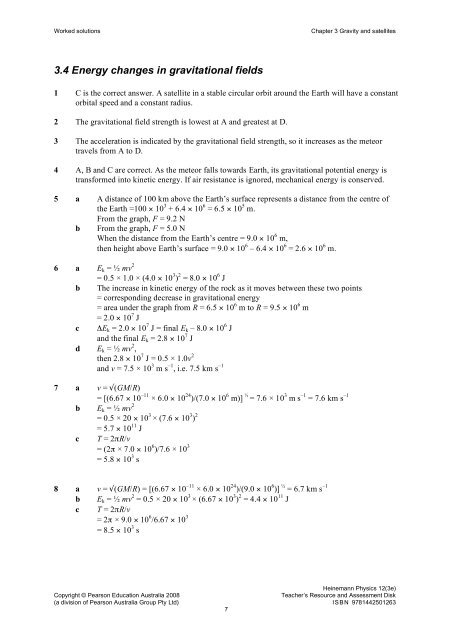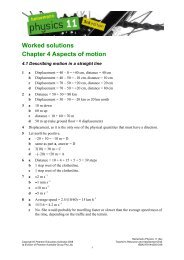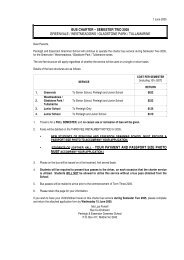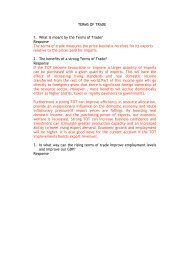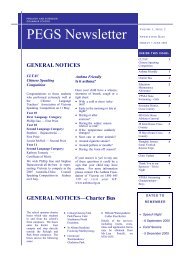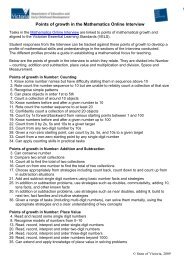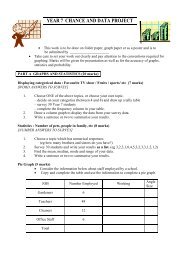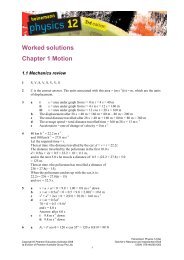Worked solutions Chapter 3 Gravity and satellites - PEGSnet
Worked solutions Chapter 3 Gravity and satellites - PEGSnet
Worked solutions Chapter 3 Gravity and satellites - PEGSnet
Create successful ePaper yourself
Turn your PDF publications into a flip-book with our unique Google optimized e-Paper software.
<strong>Worked</strong> <strong>solutions</strong><strong>Chapter</strong> 3 <strong>Gravity</strong> <strong>and</strong> <strong>satellites</strong>3.4 Energy changes in gravitational fields1 C is the correct answer. A satellite in a stable circular orbit around the Earth will have a constantorbital speed <strong>and</strong> a constant radius.2 The gravitational field strength is lowest at A <strong>and</strong> greatest at D.3 The acceleration is indicated by the gravitational field strength, so it increases as the meteortravels from A to D.4 A, B <strong>and</strong> C are correct. As the meteor falls towards Earth, its gravitational potential energy istransformed into kinetic energy. If air resistance is ignored, mechanical energy is conserved.5 a A distance of 100 km above the Earth’s surface represents a distance from the centre ofthe Earth =100 × 10 3 + 6.4 × 10 6 = 6.5 × 10 5 m.From the graph, F = 9.2 Nb From the graph, F = 5.0 NWhen the distance from the Earth’s centre = 9.0 × 10 6 m,then height above Earth’s surface = 9.0 × 10 6 – 6.4 × 10 6 = 2.6 × 10 6 m.6 a E k = ½ mv 2= 0.5 × 1.0 × (4.0 × 10 3 ) 2 = 8.0 × 10 6 Jb The increase in kinetic energy of the rock as it moves between these two points= corresponding decrease in gravitational energy= area under the graph from R = 6.5 × 10 6 m to R = 9.5 × 10 6 m= 2.0 × 10 7 Jc ΔE k = 2.0 × 10 7 J = final E k – 8.0 × 10 6 J<strong>and</strong> the final E k = 2.8 × 10 7 Jd E k = ½ mv 2 ,then 2.8 × 10 7 J = 0.5 × 1.0v 2<strong>and</strong> v = 7.5 × 10 3 m s –1 , i.e. 7.5 km s –17 a v = √(GM/R)= [(6.67 × 10 –11 × 6.0 × 10 24 )/(7.0 × 10 6 m)] ½ = 7.6 × 10 3 m s –1 = 7.6 km s –1b E k = ½ mv 2= 0.5 × 20 × 10 3 × (7.6 × 10 3 ) 2= 5.7 × 10 11 Jc T = 2πR/v= (2π × 7.0 × 10 6 )/7.6 × 10 3= 5.8 × 10 3 s8 a v = √(GM/R) = [(6.67 × 10 –11 × 6.0 × 10 24 )/(9.0 × 10 6 )] ½ = 6.7 km s –1b E k = ½ mv 2 = 0.5 × 20 × 10 3 × (6.67 × 10 3 ) 2 = 4.4 × 10 11 Jc T = 2πR/v= 2π × 9.0 × 10 6 /6.67 × 10 3= 8.5 × 10 3 sHeinemann Physics 12(3e)Copyright © Pearson Education Australia 2008Teacher’s Resource <strong>and</strong> Assessment Disk(a division of Pearson Australia Group Pty Ltd) ISBN 97814425012637


